Globalisation's Impact on Gulf Cities: A Comprehensive Analysis
VerifiedAdded on 2022/09/01
|15
|4018
|18
Report
AI Summary
This report analyzes the impact and implications of globalisation on cities, with a specific focus on Gulf cities, using Dubai as a reference point. It explores the intricate relationship between globalisation and urban economic change, highlighting the significance of cities in the global economy. The report delves into the emergence of global cities, defining their characteristics and roles within the global landscape. Furthermore, it examines the connection between globalisation and urban spatial structure, considering both the positive and negative consequences of these interconnected forces. The report underscores the influence of industrialisation, urbanisation, and globalisation, exploring how these factors shape urban development and the evolution of cities within the global context.
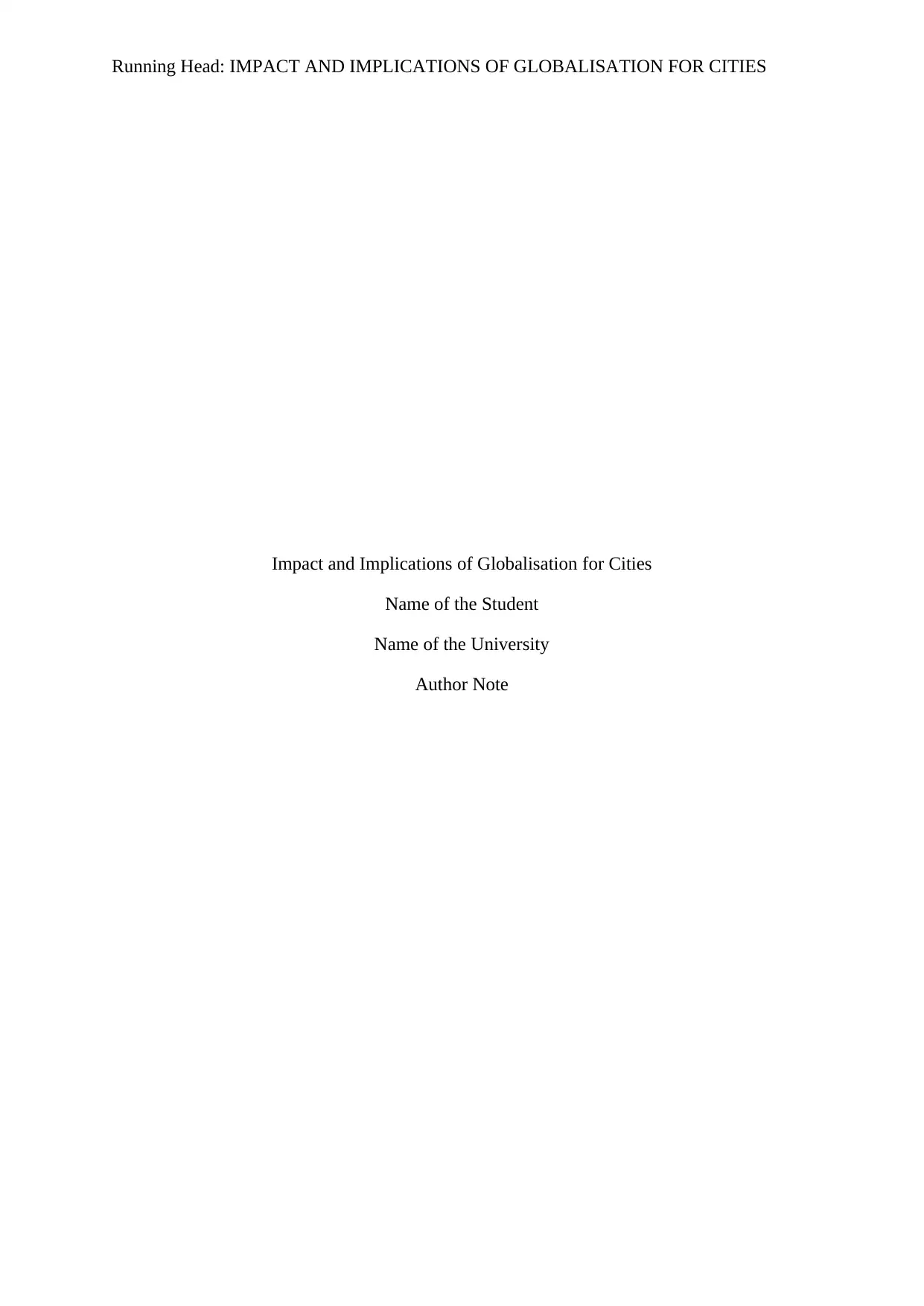
Running Head: IMPACT AND IMPLICATIONS OF GLOBALISATION FOR CITIES
Impact and Implications of Globalisation for Cities
Name of the Student
Name of the University
Author Note
Impact and Implications of Globalisation for Cities
Name of the Student
Name of the University
Author Note
Secure Best Marks with AI Grader
Need help grading? Try our AI Grader for instant feedback on your assignments.
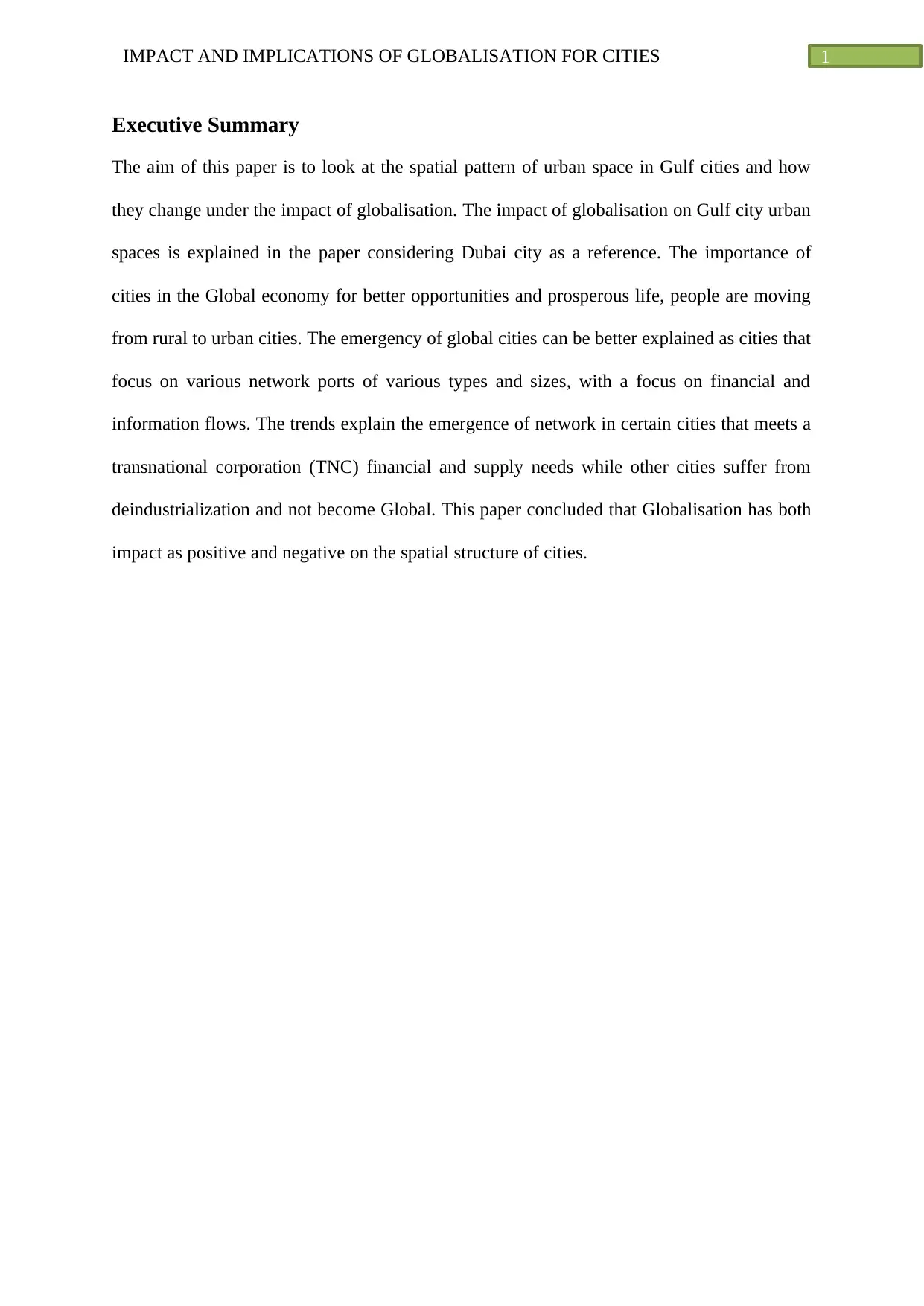
1IMPACT AND IMPLICATIONS OF GLOBALISATION FOR CITIES
Executive Summary
The aim of this paper is to look at the spatial pattern of urban space in Gulf cities and how
they change under the impact of globalisation. The impact of globalisation on Gulf city urban
spaces is explained in the paper considering Dubai city as a reference. The importance of
cities in the Global economy for better opportunities and prosperous life, people are moving
from rural to urban cities. The emergency of global cities can be better explained as cities that
focus on various network ports of various types and sizes, with a focus on financial and
information flows. The trends explain the emergence of network in certain cities that meets a
transnational corporation (TNC) financial and supply needs while other cities suffer from
deindustrialization and not become Global. This paper concluded that Globalisation has both
impact as positive and negative on the spatial structure of cities.
Executive Summary
The aim of this paper is to look at the spatial pattern of urban space in Gulf cities and how
they change under the impact of globalisation. The impact of globalisation on Gulf city urban
spaces is explained in the paper considering Dubai city as a reference. The importance of
cities in the Global economy for better opportunities and prosperous life, people are moving
from rural to urban cities. The emergency of global cities can be better explained as cities that
focus on various network ports of various types and sizes, with a focus on financial and
information flows. The trends explain the emergence of network in certain cities that meets a
transnational corporation (TNC) financial and supply needs while other cities suffer from
deindustrialization and not become Global. This paper concluded that Globalisation has both
impact as positive and negative on the spatial structure of cities.
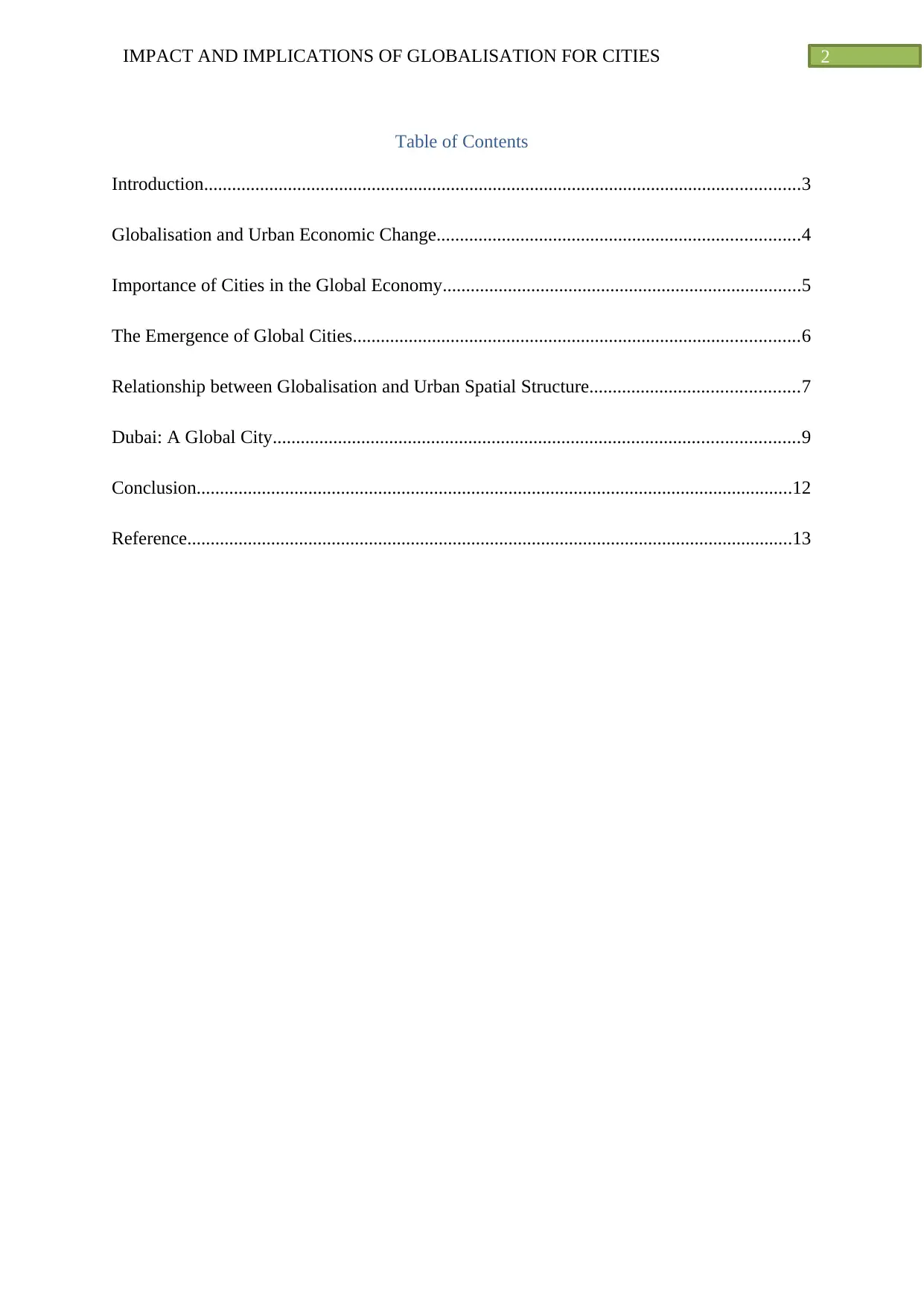
2IMPACT AND IMPLICATIONS OF GLOBALISATION FOR CITIES
Table of Contents
Introduction................................................................................................................................3
Globalisation and Urban Economic Change..............................................................................4
Importance of Cities in the Global Economy.............................................................................5
The Emergence of Global Cities................................................................................................6
Relationship between Globalisation and Urban Spatial Structure.............................................7
Dubai: A Global City.................................................................................................................9
Conclusion................................................................................................................................12
Reference..................................................................................................................................13
Table of Contents
Introduction................................................................................................................................3
Globalisation and Urban Economic Change..............................................................................4
Importance of Cities in the Global Economy.............................................................................5
The Emergence of Global Cities................................................................................................6
Relationship between Globalisation and Urban Spatial Structure.............................................7
Dubai: A Global City.................................................................................................................9
Conclusion................................................................................................................................12
Reference..................................................................................................................................13
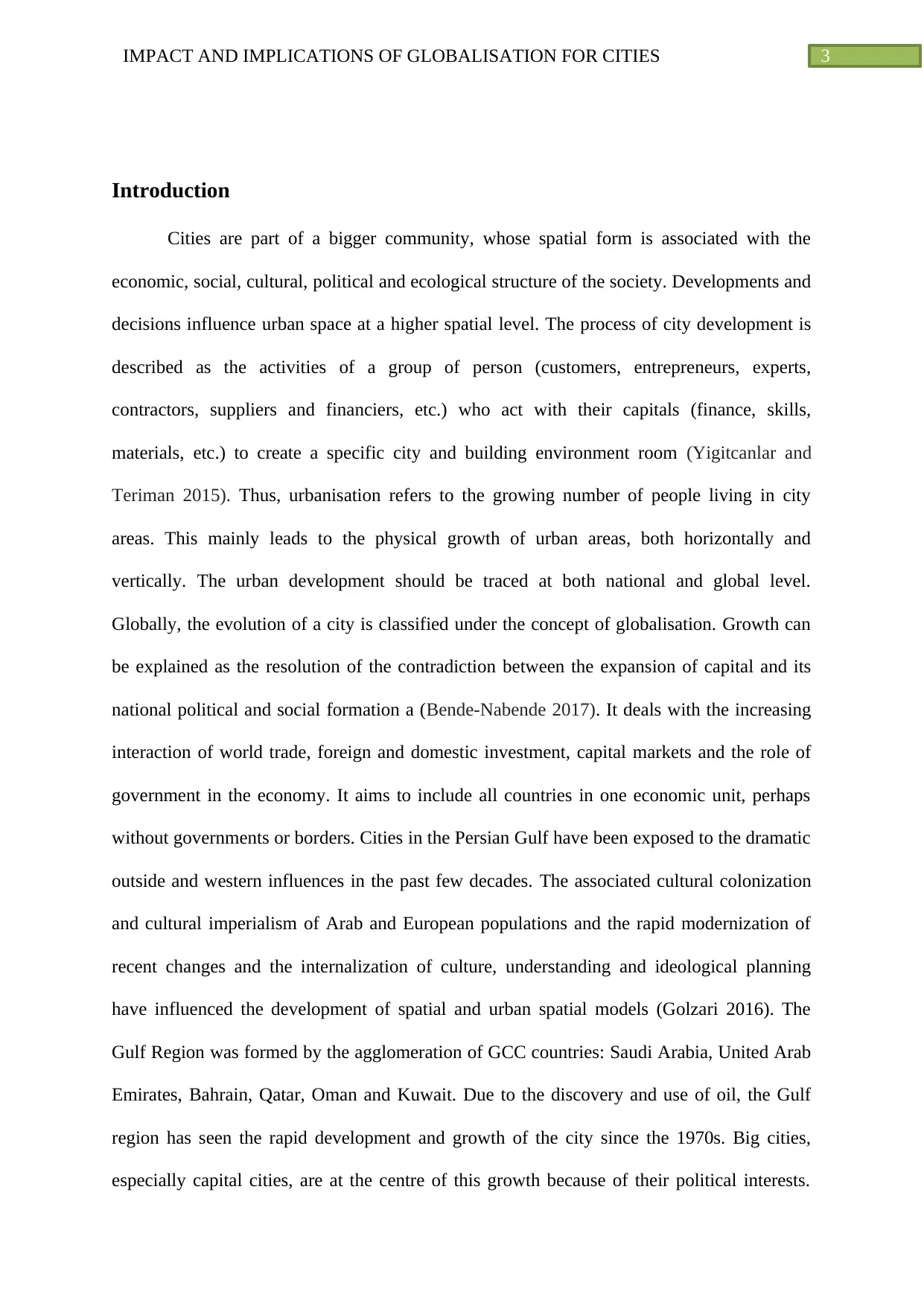
3IMPACT AND IMPLICATIONS OF GLOBALISATION FOR CITIES
Introduction
Cities are part of a bigger community, whose spatial form is associated with the
economic, social, cultural, political and ecological structure of the society. Developments and
decisions influence urban space at a higher spatial level. The process of city development is
described as the activities of a group of person (customers, entrepreneurs, experts,
contractors, suppliers and financiers, etc.) who act with their capitals (finance, skills,
materials, etc.) to create a specific city and building environment room (Yigitcanlar and
Teriman 2015). Thus, urbanisation refers to the growing number of people living in city
areas. This mainly leads to the physical growth of urban areas, both horizontally and
vertically. The urban development should be traced at both national and global level.
Globally, the evolution of a city is classified under the concept of globalisation. Growth can
be explained as the resolution of the contradiction between the expansion of capital and its
national political and social formation a (Bende-Nabende 2017). It deals with the increasing
interaction of world trade, foreign and domestic investment, capital markets and the role of
government in the economy. It aims to include all countries in one economic unit, perhaps
without governments or borders. Cities in the Persian Gulf have been exposed to the dramatic
outside and western influences in the past few decades. The associated cultural colonization
and cultural imperialism of Arab and European populations and the rapid modernization of
recent changes and the internalization of culture, understanding and ideological planning
have influenced the development of spatial and urban spatial models (Golzari 2016). The
Gulf Region was formed by the agglomeration of GCC countries: Saudi Arabia, United Arab
Emirates, Bahrain, Qatar, Oman and Kuwait. Due to the discovery and use of oil, the Gulf
region has seen the rapid development and growth of the city since the 1970s. Big cities,
especially capital cities, are at the centre of this growth because of their political interests.
Introduction
Cities are part of a bigger community, whose spatial form is associated with the
economic, social, cultural, political and ecological structure of the society. Developments and
decisions influence urban space at a higher spatial level. The process of city development is
described as the activities of a group of person (customers, entrepreneurs, experts,
contractors, suppliers and financiers, etc.) who act with their capitals (finance, skills,
materials, etc.) to create a specific city and building environment room (Yigitcanlar and
Teriman 2015). Thus, urbanisation refers to the growing number of people living in city
areas. This mainly leads to the physical growth of urban areas, both horizontally and
vertically. The urban development should be traced at both national and global level.
Globally, the evolution of a city is classified under the concept of globalisation. Growth can
be explained as the resolution of the contradiction between the expansion of capital and its
national political and social formation a (Bende-Nabende 2017). It deals with the increasing
interaction of world trade, foreign and domestic investment, capital markets and the role of
government in the economy. It aims to include all countries in one economic unit, perhaps
without governments or borders. Cities in the Persian Gulf have been exposed to the dramatic
outside and western influences in the past few decades. The associated cultural colonization
and cultural imperialism of Arab and European populations and the rapid modernization of
recent changes and the internalization of culture, understanding and ideological planning
have influenced the development of spatial and urban spatial models (Golzari 2016). The
Gulf Region was formed by the agglomeration of GCC countries: Saudi Arabia, United Arab
Emirates, Bahrain, Qatar, Oman and Kuwait. Due to the discovery and use of oil, the Gulf
region has seen the rapid development and growth of the city since the 1970s. Big cities,
especially capital cities, are at the centre of this growth because of their political interests.
Secure Best Marks with AI Grader
Need help grading? Try our AI Grader for instant feedback on your assignments.
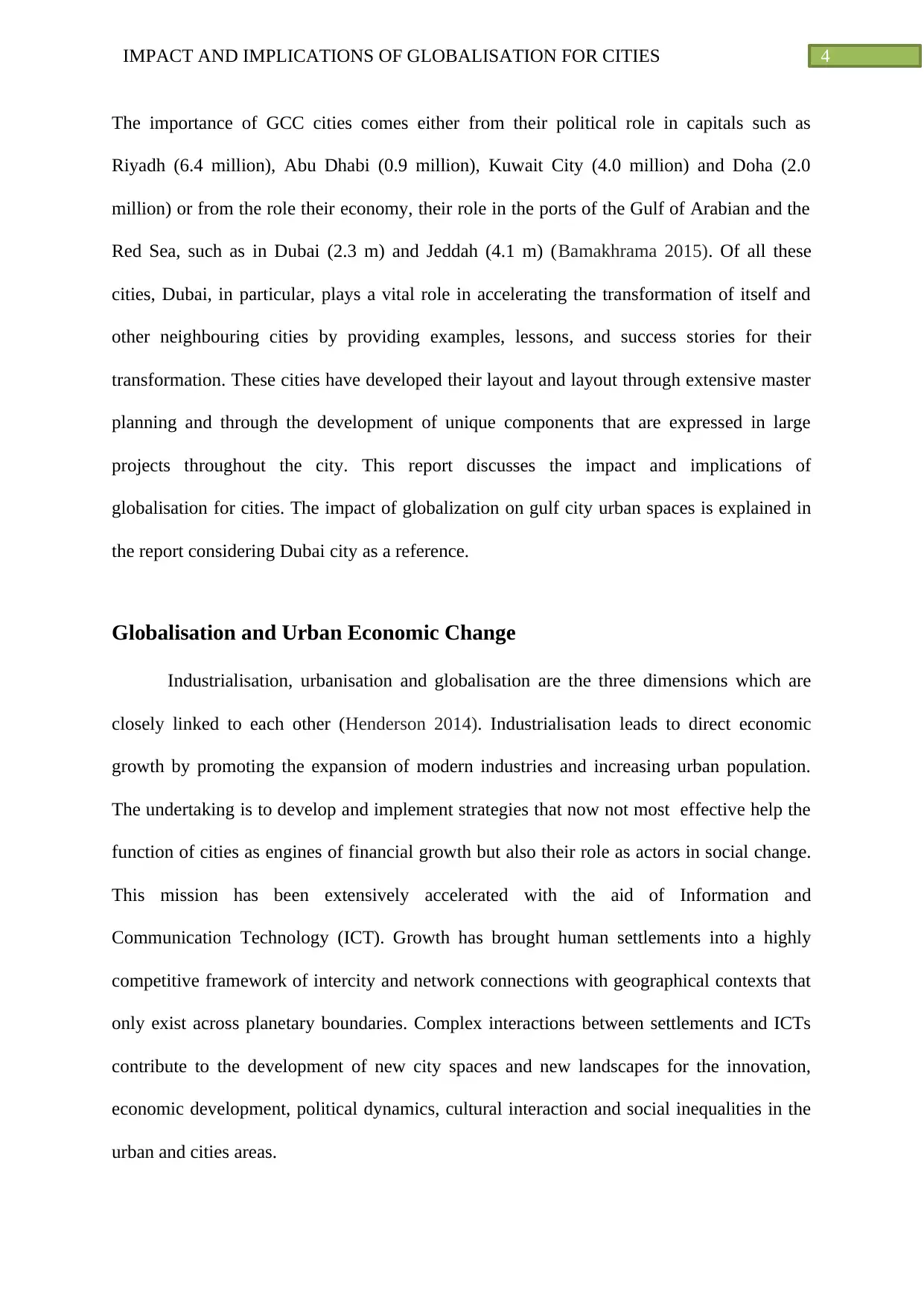
4IMPACT AND IMPLICATIONS OF GLOBALISATION FOR CITIES
The importance of GCC cities comes either from their political role in capitals such as
Riyadh (6.4 million), Abu Dhabi (0.9 million), Kuwait City (4.0 million) and Doha (2.0
million) or from the role their economy, their role in the ports of the Gulf of Arabian and the
Red Sea, such as in Dubai (2.3 m) and Jeddah (4.1 m) (Bamakhrama 2015). Of all these
cities, Dubai, in particular, plays a vital role in accelerating the transformation of itself and
other neighbouring cities by providing examples, lessons, and success stories for their
transformation. These cities have developed their layout and layout through extensive master
planning and through the development of unique components that are expressed in large
projects throughout the city. This report discusses the impact and implications of
globalisation for cities. The impact of globalization on gulf city urban spaces is explained in
the report considering Dubai city as a reference.
Globalisation and Urban Economic Change
Industrialisation, urbanisation and globalisation are the three dimensions which are
closely linked to each other (Henderson 2014). Industrialisation leads to direct economic
growth by promoting the expansion of modern industries and increasing urban population.
The undertaking is to develop and implement strategies that now not most effective help the
function of cities as engines of financial growth but also their role as actors in social change.
This mission has been extensively accelerated with the aid of Information and
Communication Technology (ICT). Growth has brought human settlements into a highly
competitive framework of intercity and network connections with geographical contexts that
only exist across planetary boundaries. Complex interactions between settlements and ICTs
contribute to the development of new city spaces and new landscapes for the innovation,
economic development, political dynamics, cultural interaction and social inequalities in the
urban and cities areas.
The importance of GCC cities comes either from their political role in capitals such as
Riyadh (6.4 million), Abu Dhabi (0.9 million), Kuwait City (4.0 million) and Doha (2.0
million) or from the role their economy, their role in the ports of the Gulf of Arabian and the
Red Sea, such as in Dubai (2.3 m) and Jeddah (4.1 m) (Bamakhrama 2015). Of all these
cities, Dubai, in particular, plays a vital role in accelerating the transformation of itself and
other neighbouring cities by providing examples, lessons, and success stories for their
transformation. These cities have developed their layout and layout through extensive master
planning and through the development of unique components that are expressed in large
projects throughout the city. This report discusses the impact and implications of
globalisation for cities. The impact of globalization on gulf city urban spaces is explained in
the report considering Dubai city as a reference.
Globalisation and Urban Economic Change
Industrialisation, urbanisation and globalisation are the three dimensions which are
closely linked to each other (Henderson 2014). Industrialisation leads to direct economic
growth by promoting the expansion of modern industries and increasing urban population.
The undertaking is to develop and implement strategies that now not most effective help the
function of cities as engines of financial growth but also their role as actors in social change.
This mission has been extensively accelerated with the aid of Information and
Communication Technology (ICT). Growth has brought human settlements into a highly
competitive framework of intercity and network connections with geographical contexts that
only exist across planetary boundaries. Complex interactions between settlements and ICTs
contribute to the development of new city spaces and new landscapes for the innovation,
economic development, political dynamics, cultural interaction and social inequalities in the
urban and cities areas.
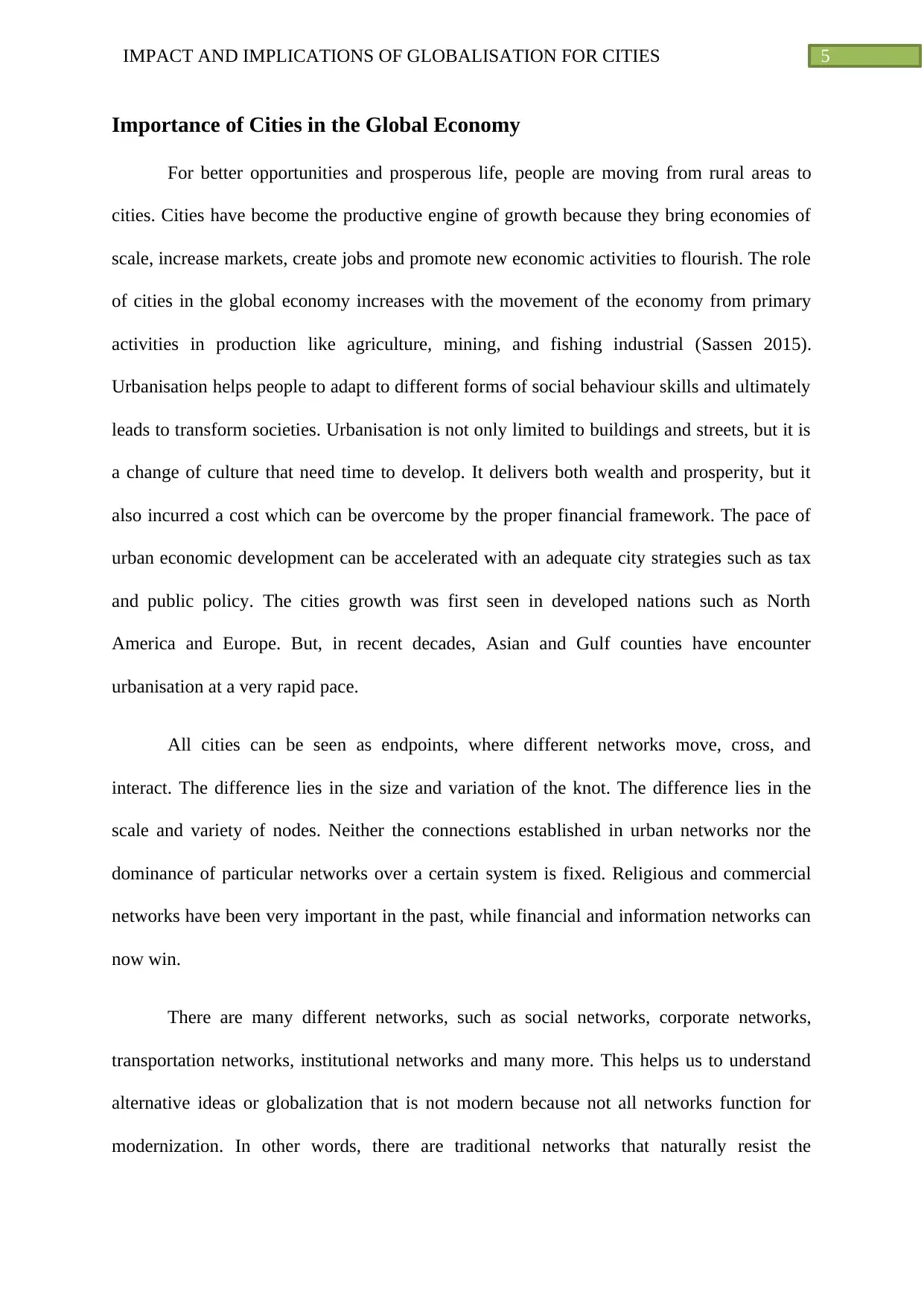
5IMPACT AND IMPLICATIONS OF GLOBALISATION FOR CITIES
Importance of Cities in the Global Economy
For better opportunities and prosperous life, people are moving from rural areas to
cities. Cities have become the productive engine of growth because they bring economies of
scale, increase markets, create jobs and promote new economic activities to flourish. The role
of cities in the global economy increases with the movement of the economy from primary
activities in production like agriculture, mining, and fishing industrial (Sassen 2015).
Urbanisation helps people to adapt to different forms of social behaviour skills and ultimately
leads to transform societies. Urbanisation is not only limited to buildings and streets, but it is
a change of culture that need time to develop. It delivers both wealth and prosperity, but it
also incurred a cost which can be overcome by the proper financial framework. The pace of
urban economic development can be accelerated with an adequate city strategies such as tax
and public policy. The cities growth was first seen in developed nations such as North
America and Europe. But, in recent decades, Asian and Gulf counties have encounter
urbanisation at a very rapid pace.
All cities can be seen as endpoints, where different networks move, cross, and
interact. The difference lies in the size and variation of the knot. The difference lies in the
scale and variety of nodes. Neither the connections established in urban networks nor the
dominance of particular networks over a certain system is fixed. Religious and commercial
networks have been very important in the past, while financial and information networks can
now win.
There are many different networks, such as social networks, corporate networks,
transportation networks, institutional networks and many more. This helps us to understand
alternative ideas or globalization that is not modern because not all networks function for
modernization. In other words, there are traditional networks that naturally resist the
Importance of Cities in the Global Economy
For better opportunities and prosperous life, people are moving from rural areas to
cities. Cities have become the productive engine of growth because they bring economies of
scale, increase markets, create jobs and promote new economic activities to flourish. The role
of cities in the global economy increases with the movement of the economy from primary
activities in production like agriculture, mining, and fishing industrial (Sassen 2015).
Urbanisation helps people to adapt to different forms of social behaviour skills and ultimately
leads to transform societies. Urbanisation is not only limited to buildings and streets, but it is
a change of culture that need time to develop. It delivers both wealth and prosperity, but it
also incurred a cost which can be overcome by the proper financial framework. The pace of
urban economic development can be accelerated with an adequate city strategies such as tax
and public policy. The cities growth was first seen in developed nations such as North
America and Europe. But, in recent decades, Asian and Gulf counties have encounter
urbanisation at a very rapid pace.
All cities can be seen as endpoints, where different networks move, cross, and
interact. The difference lies in the size and variation of the knot. The difference lies in the
scale and variety of nodes. Neither the connections established in urban networks nor the
dominance of particular networks over a certain system is fixed. Religious and commercial
networks have been very important in the past, while financial and information networks can
now win.
There are many different networks, such as social networks, corporate networks,
transportation networks, institutional networks and many more. This helps us to understand
alternative ideas or globalization that is not modern because not all networks function for
modernization. In other words, there are traditional networks that naturally resist the
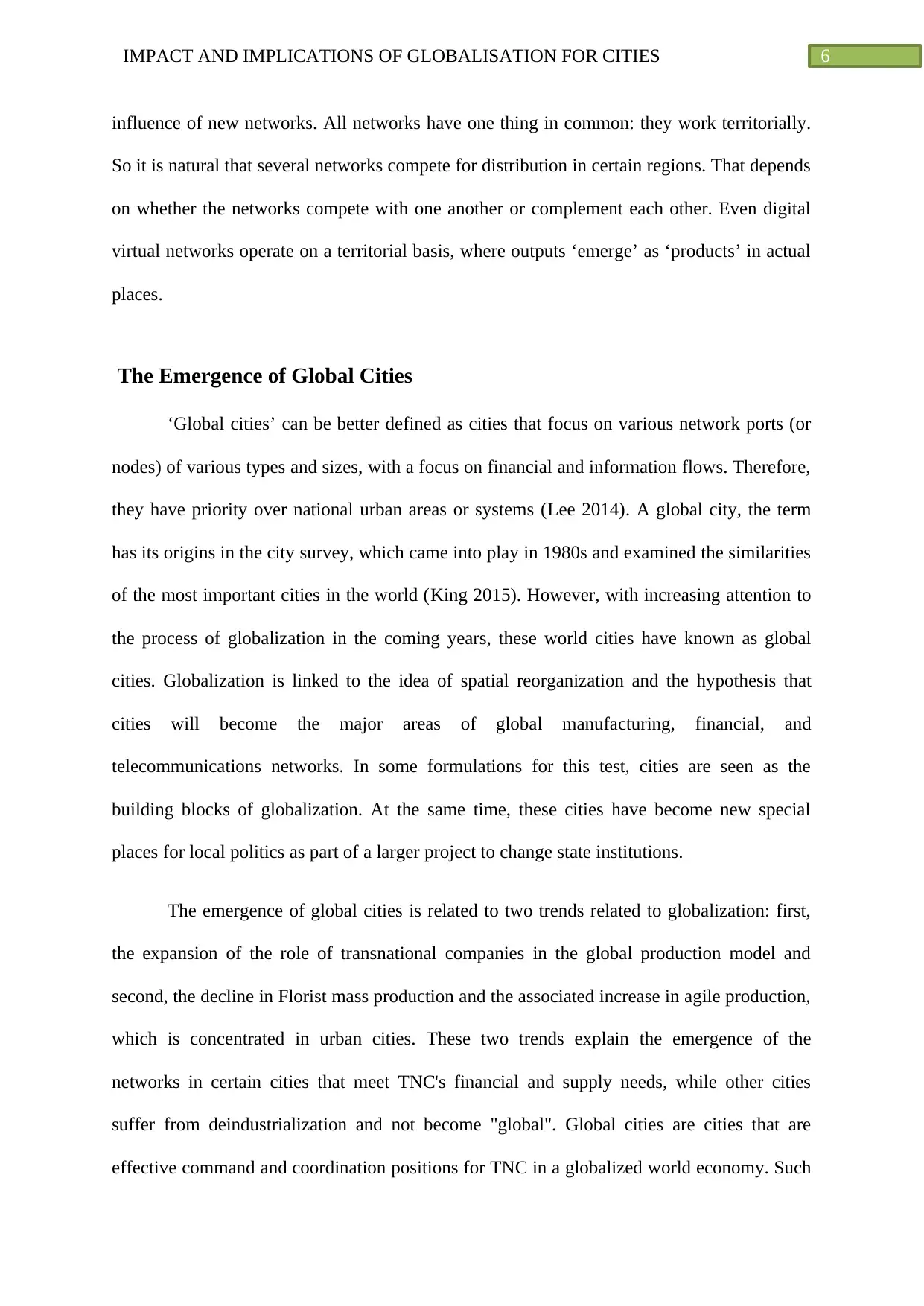
6IMPACT AND IMPLICATIONS OF GLOBALISATION FOR CITIES
influence of new networks. All networks have one thing in common: they work territorially.
So it is natural that several networks compete for distribution in certain regions. That depends
on whether the networks compete with one another or complement each other. Even digital
virtual networks operate on a territorial basis, where outputs ‘emerge’ as ‘products’ in actual
places.
The Emergence of Global Cities
‘Global cities’ can be better defined as cities that focus on various network ports (or
nodes) of various types and sizes, with a focus on financial and information flows. Therefore,
they have priority over national urban areas or systems (Lee 2014). A global city, the term
has its origins in the city survey, which came into play in 1980s and examined the similarities
of the most important cities in the world (King 2015). However, with increasing attention to
the process of globalization in the coming years, these world cities have known as global
cities. Globalization is linked to the idea of spatial reorganization and the hypothesis that
cities will become the major areas of global manufacturing, financial, and
telecommunications networks. In some formulations for this test, cities are seen as the
building blocks of globalization. At the same time, these cities have become new special
places for local politics as part of a larger project to change state institutions.
The emergence of global cities is related to two trends related to globalization: first,
the expansion of the role of transnational companies in the global production model and
second, the decline in Florist mass production and the associated increase in agile production,
which is concentrated in urban cities. These two trends explain the emergence of the
networks in certain cities that meet TNC's financial and supply needs, while other cities
suffer from deindustrialization and not become "global". Global cities are cities that are
effective command and coordination positions for TNC in a globalized world economy. Such
influence of new networks. All networks have one thing in common: they work territorially.
So it is natural that several networks compete for distribution in certain regions. That depends
on whether the networks compete with one another or complement each other. Even digital
virtual networks operate on a territorial basis, where outputs ‘emerge’ as ‘products’ in actual
places.
The Emergence of Global Cities
‘Global cities’ can be better defined as cities that focus on various network ports (or
nodes) of various types and sizes, with a focus on financial and information flows. Therefore,
they have priority over national urban areas or systems (Lee 2014). A global city, the term
has its origins in the city survey, which came into play in 1980s and examined the similarities
of the most important cities in the world (King 2015). However, with increasing attention to
the process of globalization in the coming years, these world cities have known as global
cities. Globalization is linked to the idea of spatial reorganization and the hypothesis that
cities will become the major areas of global manufacturing, financial, and
telecommunications networks. In some formulations for this test, cities are seen as the
building blocks of globalization. At the same time, these cities have become new special
places for local politics as part of a larger project to change state institutions.
The emergence of global cities is related to two trends related to globalization: first,
the expansion of the role of transnational companies in the global production model and
second, the decline in Florist mass production and the associated increase in agile production,
which is concentrated in urban cities. These two trends explain the emergence of the
networks in certain cities that meet TNC's financial and supply needs, while other cities
suffer from deindustrialization and not become "global". Global cities are cities that are
effective command and coordination positions for TNC in a globalized world economy. Such
Paraphrase This Document
Need a fresh take? Get an instant paraphrase of this document with our AI Paraphraser
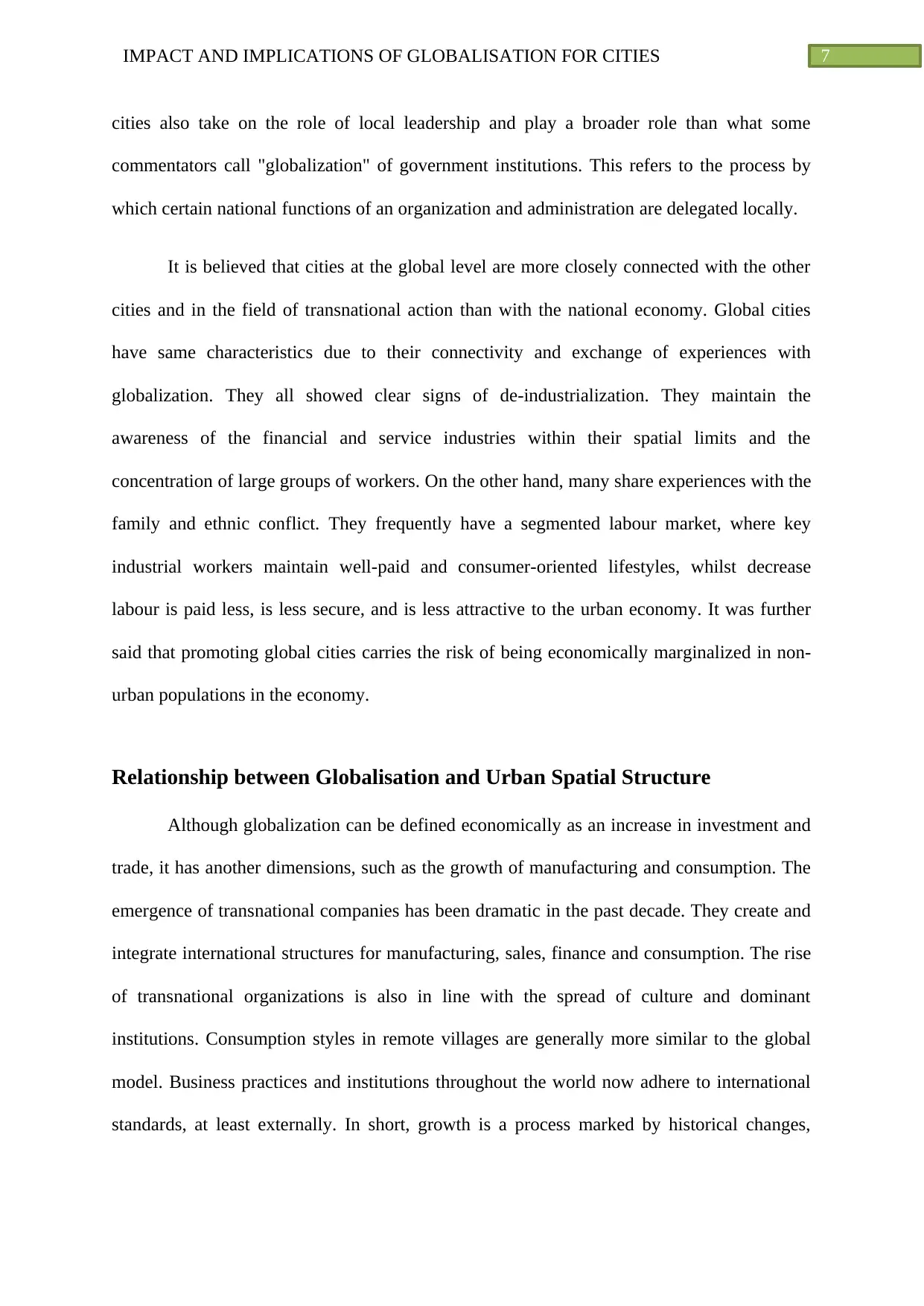
7IMPACT AND IMPLICATIONS OF GLOBALISATION FOR CITIES
cities also take on the role of local leadership and play a broader role than what some
commentators call "globalization" of government institutions. This refers to the process by
which certain national functions of an organization and administration are delegated locally.
It is believed that cities at the global level are more closely connected with the other
cities and in the field of transnational action than with the national economy. Global cities
have same characteristics due to their connectivity and exchange of experiences with
globalization. They all showed clear signs of de-industrialization. They maintain the
awareness of the financial and service industries within their spatial limits and the
concentration of large groups of workers. On the other hand, many share experiences with the
family and ethnic conflict. They frequently have a segmented labour market, where key
industrial workers maintain well-paid and consumer-oriented lifestyles, whilst decrease
labour is paid less, is less secure, and is less attractive to the urban economy. It was further
said that promoting global cities carries the risk of being economically marginalized in non-
urban populations in the economy.
Relationship between Globalisation and Urban Spatial Structure
Although globalization can be defined economically as an increase in investment and
trade, it has another dimensions, such as the growth of manufacturing and consumption. The
emergence of transnational companies has been dramatic in the past decade. They create and
integrate international structures for manufacturing, sales, finance and consumption. The rise
of transnational organizations is also in line with the spread of culture and dominant
institutions. Consumption styles in remote villages are generally more similar to the global
model. Business practices and institutions throughout the world now adhere to international
standards, at least externally. In short, growth is a process marked by historical changes,
cities also take on the role of local leadership and play a broader role than what some
commentators call "globalization" of government institutions. This refers to the process by
which certain national functions of an organization and administration are delegated locally.
It is believed that cities at the global level are more closely connected with the other
cities and in the field of transnational action than with the national economy. Global cities
have same characteristics due to their connectivity and exchange of experiences with
globalization. They all showed clear signs of de-industrialization. They maintain the
awareness of the financial and service industries within their spatial limits and the
concentration of large groups of workers. On the other hand, many share experiences with the
family and ethnic conflict. They frequently have a segmented labour market, where key
industrial workers maintain well-paid and consumer-oriented lifestyles, whilst decrease
labour is paid less, is less secure, and is less attractive to the urban economy. It was further
said that promoting global cities carries the risk of being economically marginalized in non-
urban populations in the economy.
Relationship between Globalisation and Urban Spatial Structure
Although globalization can be defined economically as an increase in investment and
trade, it has another dimensions, such as the growth of manufacturing and consumption. The
emergence of transnational companies has been dramatic in the past decade. They create and
integrate international structures for manufacturing, sales, finance and consumption. The rise
of transnational organizations is also in line with the spread of culture and dominant
institutions. Consumption styles in remote villages are generally more similar to the global
model. Business practices and institutions throughout the world now adhere to international
standards, at least externally. In short, growth is a process marked by historical changes,
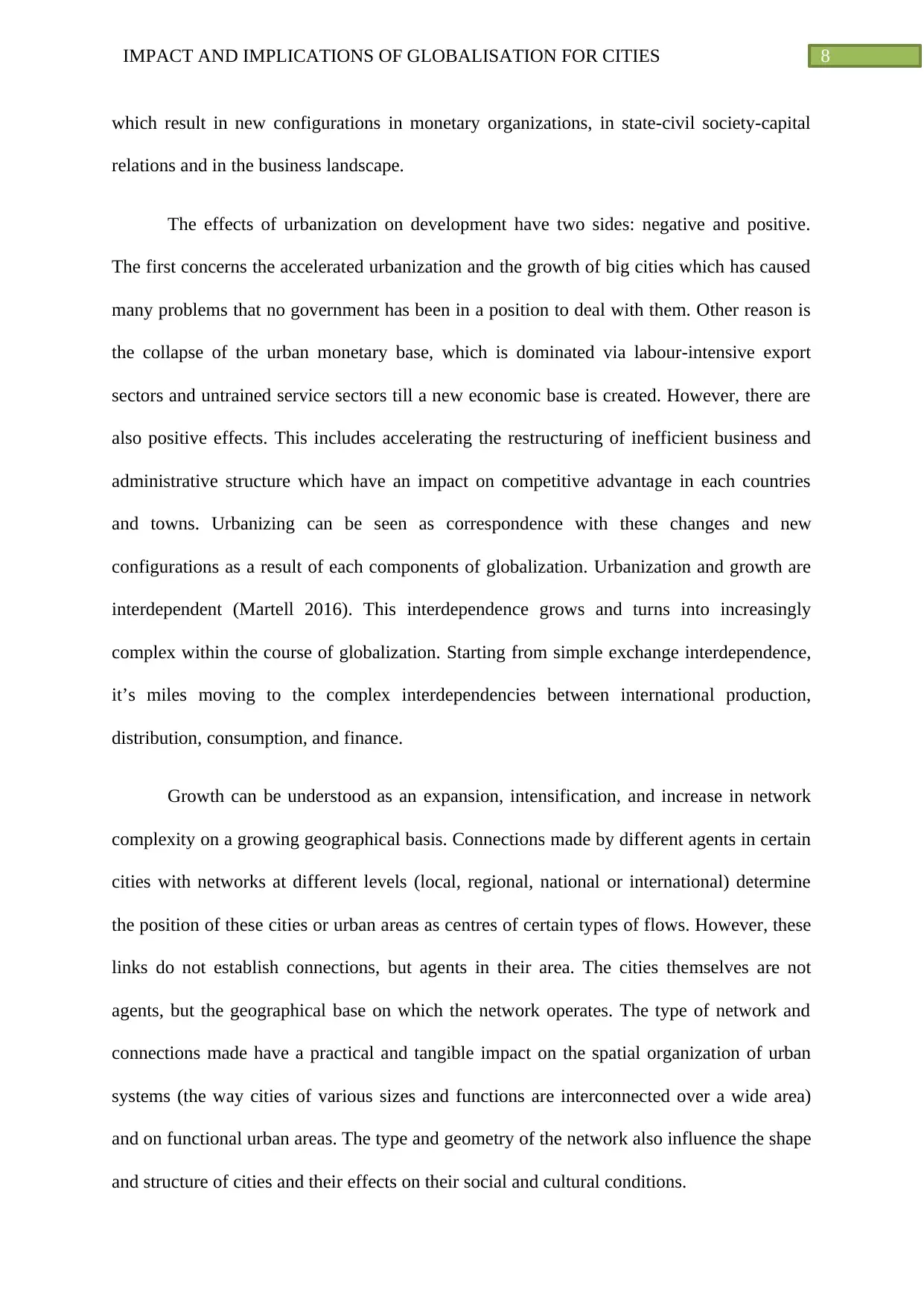
8IMPACT AND IMPLICATIONS OF GLOBALISATION FOR CITIES
which result in new configurations in monetary organizations, in state-civil society-capital
relations and in the business landscape.
The effects of urbanization on development have two sides: negative and positive.
The first concerns the accelerated urbanization and the growth of big cities which has caused
many problems that no government has been in a position to deal with them. Other reason is
the collapse of the urban monetary base, which is dominated via labour-intensive export
sectors and untrained service sectors till a new economic base is created. However, there are
also positive effects. This includes accelerating the restructuring of inefficient business and
administrative structure which have an impact on competitive advantage in each countries
and towns. Urbanizing can be seen as correspondence with these changes and new
configurations as a result of each components of globalization. Urbanization and growth are
interdependent (Martell 2016). This interdependence grows and turns into increasingly
complex within the course of globalization. Starting from simple exchange interdependence,
it’s miles moving to the complex interdependencies between international production,
distribution, consumption, and finance.
Growth can be understood as an expansion, intensification, and increase in network
complexity on a growing geographical basis. Connections made by different agents in certain
cities with networks at different levels (local, regional, national or international) determine
the position of these cities or urban areas as centres of certain types of flows. However, these
links do not establish connections, but agents in their area. The cities themselves are not
agents, but the geographical base on which the network operates. The type of network and
connections made have a practical and tangible impact on the spatial organization of urban
systems (the way cities of various sizes and functions are interconnected over a wide area)
and on functional urban areas. The type and geometry of the network also influence the shape
and structure of cities and their effects on their social and cultural conditions.
which result in new configurations in monetary organizations, in state-civil society-capital
relations and in the business landscape.
The effects of urbanization on development have two sides: negative and positive.
The first concerns the accelerated urbanization and the growth of big cities which has caused
many problems that no government has been in a position to deal with them. Other reason is
the collapse of the urban monetary base, which is dominated via labour-intensive export
sectors and untrained service sectors till a new economic base is created. However, there are
also positive effects. This includes accelerating the restructuring of inefficient business and
administrative structure which have an impact on competitive advantage in each countries
and towns. Urbanizing can be seen as correspondence with these changes and new
configurations as a result of each components of globalization. Urbanization and growth are
interdependent (Martell 2016). This interdependence grows and turns into increasingly
complex within the course of globalization. Starting from simple exchange interdependence,
it’s miles moving to the complex interdependencies between international production,
distribution, consumption, and finance.
Growth can be understood as an expansion, intensification, and increase in network
complexity on a growing geographical basis. Connections made by different agents in certain
cities with networks at different levels (local, regional, national or international) determine
the position of these cities or urban areas as centres of certain types of flows. However, these
links do not establish connections, but agents in their area. The cities themselves are not
agents, but the geographical base on which the network operates. The type of network and
connections made have a practical and tangible impact on the spatial organization of urban
systems (the way cities of various sizes and functions are interconnected over a wide area)
and on functional urban areas. The type and geometry of the network also influence the shape
and structure of cities and their effects on their social and cultural conditions.
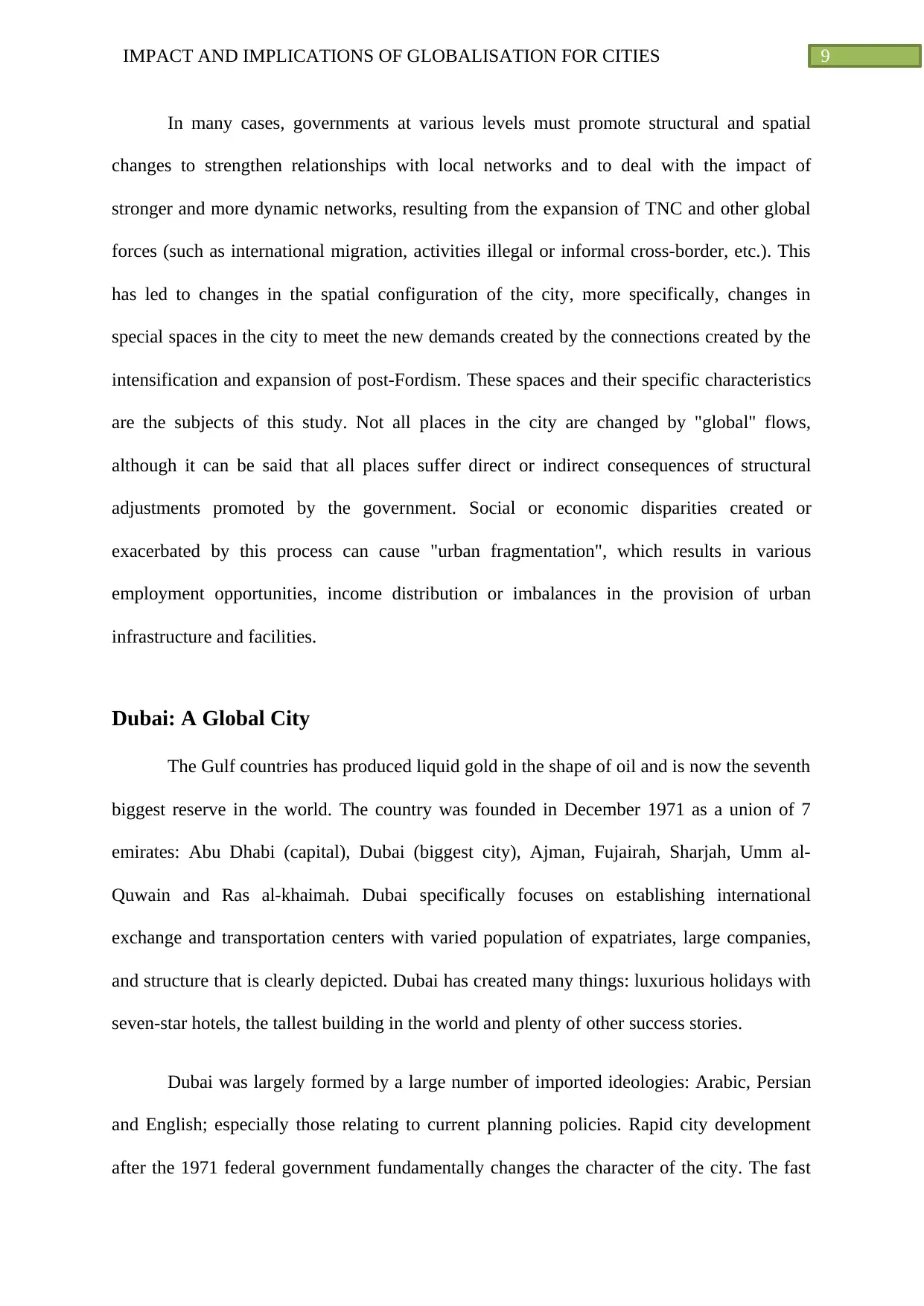
9IMPACT AND IMPLICATIONS OF GLOBALISATION FOR CITIES
In many cases, governments at various levels must promote structural and spatial
changes to strengthen relationships with local networks and to deal with the impact of
stronger and more dynamic networks, resulting from the expansion of TNC and other global
forces (such as international migration, activities illegal or informal cross-border, etc.). This
has led to changes in the spatial configuration of the city, more specifically, changes in
special spaces in the city to meet the new demands created by the connections created by the
intensification and expansion of post-Fordism. These spaces and their specific characteristics
are the subjects of this study. Not all places in the city are changed by "global" flows,
although it can be said that all places suffer direct or indirect consequences of structural
adjustments promoted by the government. Social or economic disparities created or
exacerbated by this process can cause "urban fragmentation", which results in various
employment opportunities, income distribution or imbalances in the provision of urban
infrastructure and facilities.
Dubai: A Global City
The Gulf countries has produced liquid gold in the shape of oil and is now the seventh
biggest reserve in the world. The country was founded in December 1971 as a union of 7
emirates: Abu Dhabi (capital), Dubai (biggest city), Ajman, Fujairah, Sharjah, Umm al-
Quwain and Ras al-khaimah. Dubai specifically focuses on establishing international
exchange and transportation centers with varied population of expatriates, large companies,
and structure that is clearly depicted. Dubai has created many things: luxurious holidays with
seven-star hotels, the tallest building in the world and plenty of other success stories.
Dubai was largely formed by a large number of imported ideologies: Arabic, Persian
and English; especially those relating to current planning policies. Rapid city development
after the 1971 federal government fundamentally changes the character of the city. The fast
In many cases, governments at various levels must promote structural and spatial
changes to strengthen relationships with local networks and to deal with the impact of
stronger and more dynamic networks, resulting from the expansion of TNC and other global
forces (such as international migration, activities illegal or informal cross-border, etc.). This
has led to changes in the spatial configuration of the city, more specifically, changes in
special spaces in the city to meet the new demands created by the connections created by the
intensification and expansion of post-Fordism. These spaces and their specific characteristics
are the subjects of this study. Not all places in the city are changed by "global" flows,
although it can be said that all places suffer direct or indirect consequences of structural
adjustments promoted by the government. Social or economic disparities created or
exacerbated by this process can cause "urban fragmentation", which results in various
employment opportunities, income distribution or imbalances in the provision of urban
infrastructure and facilities.
Dubai: A Global City
The Gulf countries has produced liquid gold in the shape of oil and is now the seventh
biggest reserve in the world. The country was founded in December 1971 as a union of 7
emirates: Abu Dhabi (capital), Dubai (biggest city), Ajman, Fujairah, Sharjah, Umm al-
Quwain and Ras al-khaimah. Dubai specifically focuses on establishing international
exchange and transportation centers with varied population of expatriates, large companies,
and structure that is clearly depicted. Dubai has created many things: luxurious holidays with
seven-star hotels, the tallest building in the world and plenty of other success stories.
Dubai was largely formed by a large number of imported ideologies: Arabic, Persian
and English; especially those relating to current planning policies. Rapid city development
after the 1971 federal government fundamentally changes the character of the city. The fast
Secure Best Marks with AI Grader
Need help grading? Try our AI Grader for instant feedback on your assignments.
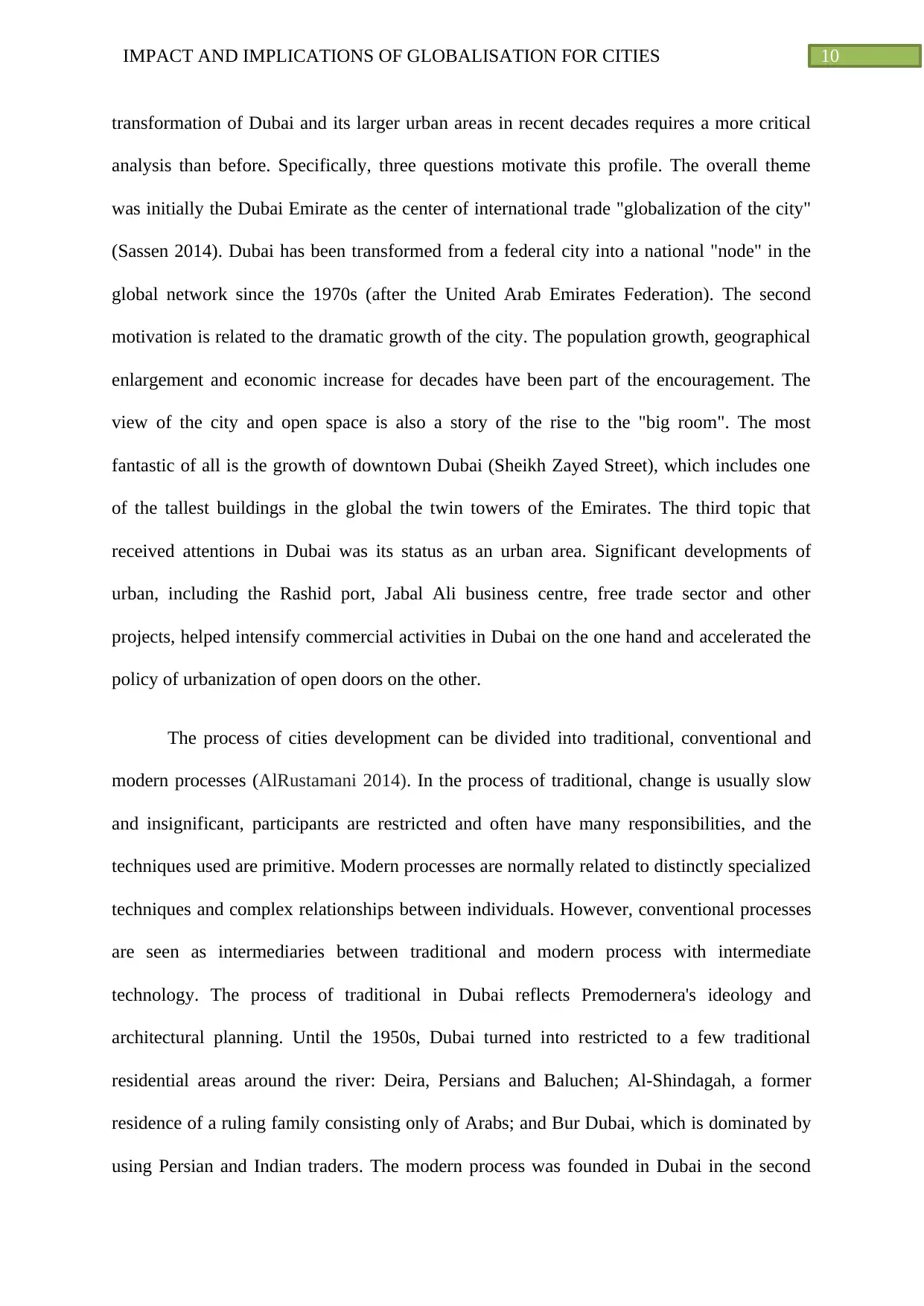
10IMPACT AND IMPLICATIONS OF GLOBALISATION FOR CITIES
transformation of Dubai and its larger urban areas in recent decades requires a more critical
analysis than before. Specifically, three questions motivate this profile. The overall theme
was initially the Dubai Emirate as the center of international trade "globalization of the city"
(Sassen 2014). Dubai has been transformed from a federal city into a national "node" in the
global network since the 1970s (after the United Arab Emirates Federation). The second
motivation is related to the dramatic growth of the city. The population growth, geographical
enlargement and economic increase for decades have been part of the encouragement. The
view of the city and open space is also a story of the rise to the "big room". The most
fantastic of all is the growth of downtown Dubai (Sheikh Zayed Street), which includes one
of the tallest buildings in the global the twin towers of the Emirates. The third topic that
received attentions in Dubai was its status as an urban area. Significant developments of
urban, including the Rashid port, Jabal Ali business centre, free trade sector and other
projects, helped intensify commercial activities in Dubai on the one hand and accelerated the
policy of urbanization of open doors on the other.
The process of cities development can be divided into traditional, conventional and
modern processes (AlRustamani 2014). In the process of traditional, change is usually slow
and insignificant, participants are restricted and often have many responsibilities, and the
techniques used are primitive. Modern processes are normally related to distinctly specialized
techniques and complex relationships between individuals. However, conventional processes
are seen as intermediaries between traditional and modern process with intermediate
technology. The process of traditional in Dubai reflects Premodernera's ideology and
architectural planning. Until the 1950s, Dubai turned into restricted to a few traditional
residential areas around the river: Deira, Persians and Baluchen; Al-Shindagah, a former
residence of a ruling family consisting only of Arabs; and Bur Dubai, which is dominated by
using Persian and Indian traders. The modern process was founded in Dubai in the second
transformation of Dubai and its larger urban areas in recent decades requires a more critical
analysis than before. Specifically, three questions motivate this profile. The overall theme
was initially the Dubai Emirate as the center of international trade "globalization of the city"
(Sassen 2014). Dubai has been transformed from a federal city into a national "node" in the
global network since the 1970s (after the United Arab Emirates Federation). The second
motivation is related to the dramatic growth of the city. The population growth, geographical
enlargement and economic increase for decades have been part of the encouragement. The
view of the city and open space is also a story of the rise to the "big room". The most
fantastic of all is the growth of downtown Dubai (Sheikh Zayed Street), which includes one
of the tallest buildings in the global the twin towers of the Emirates. The third topic that
received attentions in Dubai was its status as an urban area. Significant developments of
urban, including the Rashid port, Jabal Ali business centre, free trade sector and other
projects, helped intensify commercial activities in Dubai on the one hand and accelerated the
policy of urbanization of open doors on the other.
The process of cities development can be divided into traditional, conventional and
modern processes (AlRustamani 2014). In the process of traditional, change is usually slow
and insignificant, participants are restricted and often have many responsibilities, and the
techniques used are primitive. Modern processes are normally related to distinctly specialized
techniques and complex relationships between individuals. However, conventional processes
are seen as intermediaries between traditional and modern process with intermediate
technology. The process of traditional in Dubai reflects Premodernera's ideology and
architectural planning. Until the 1950s, Dubai turned into restricted to a few traditional
residential areas around the river: Deira, Persians and Baluchen; Al-Shindagah, a former
residence of a ruling family consisting only of Arabs; and Bur Dubai, which is dominated by
using Persian and Indian traders. The modern process was founded in Dubai in the second
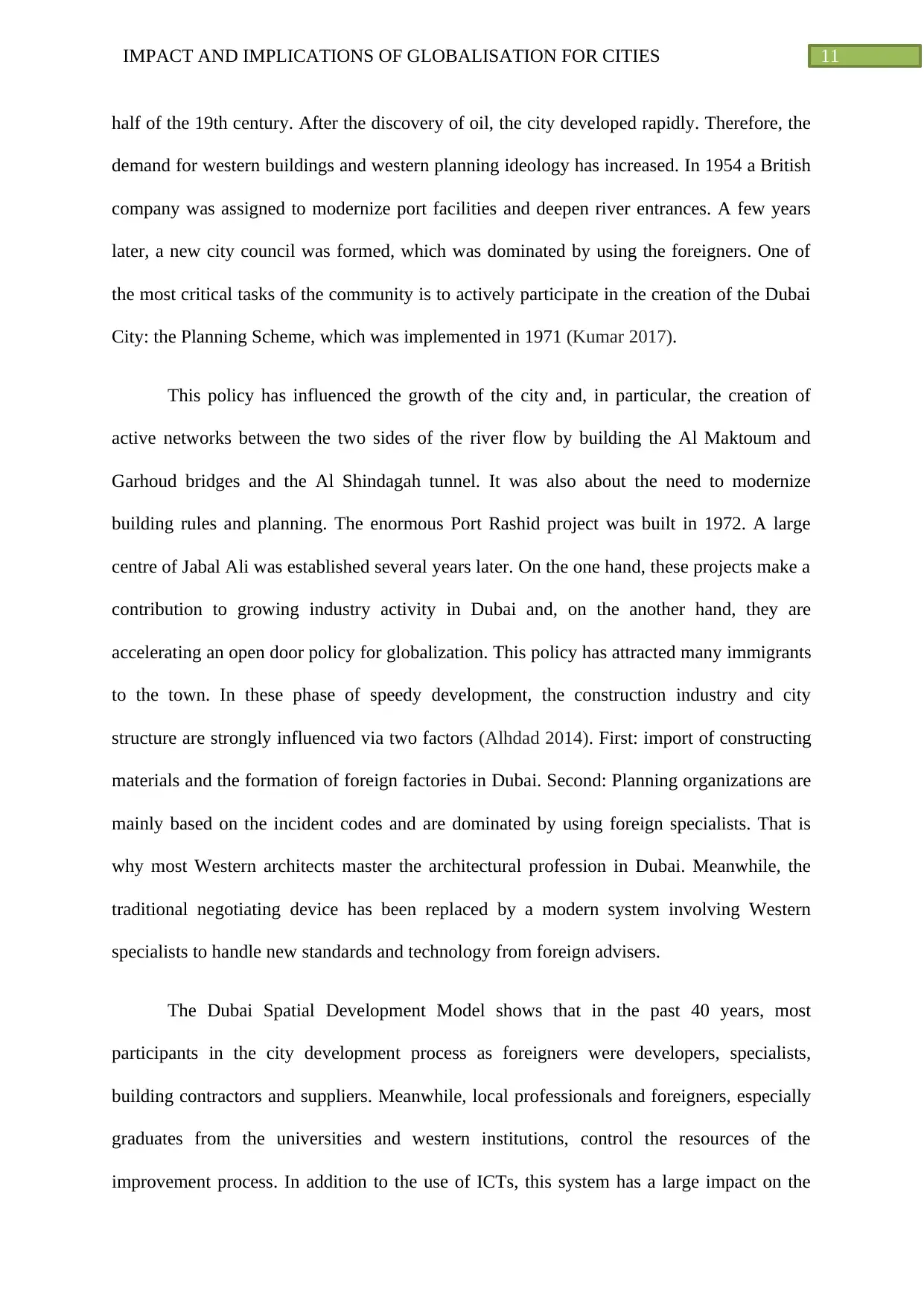
11IMPACT AND IMPLICATIONS OF GLOBALISATION FOR CITIES
half of the 19th century. After the discovery of oil, the city developed rapidly. Therefore, the
demand for western buildings and western planning ideology has increased. In 1954 a British
company was assigned to modernize port facilities and deepen river entrances. A few years
later, a new city council was formed, which was dominated by using the foreigners. One of
the most critical tasks of the community is to actively participate in the creation of the Dubai
City: the Planning Scheme, which was implemented in 1971 (Kumar 2017).
This policy has influenced the growth of the city and, in particular, the creation of
active networks between the two sides of the river flow by building the Al Maktoum and
Garhoud bridges and the Al Shindagah tunnel. It was also about the need to modernize
building rules and planning. The enormous Port Rashid project was built in 1972. A large
centre of Jabal Ali was established several years later. On the one hand, these projects make a
contribution to growing industry activity in Dubai and, on the another hand, they are
accelerating an open door policy for globalization. This policy has attracted many immigrants
to the town. In these phase of speedy development, the construction industry and city
structure are strongly influenced via two factors (Alhdad 2014). First: import of constructing
materials and the formation of foreign factories in Dubai. Second: Planning organizations are
mainly based on the incident codes and are dominated by using foreign specialists. That is
why most Western architects master the architectural profession in Dubai. Meanwhile, the
traditional negotiating device has been replaced by a modern system involving Western
specialists to handle new standards and technology from foreign advisers.
The Dubai Spatial Development Model shows that in the past 40 years, most
participants in the city development process as foreigners were developers, specialists,
building contractors and suppliers. Meanwhile, local professionals and foreigners, especially
graduates from the universities and western institutions, control the resources of the
improvement process. In addition to the use of ICTs, this system has a large impact on the
half of the 19th century. After the discovery of oil, the city developed rapidly. Therefore, the
demand for western buildings and western planning ideology has increased. In 1954 a British
company was assigned to modernize port facilities and deepen river entrances. A few years
later, a new city council was formed, which was dominated by using the foreigners. One of
the most critical tasks of the community is to actively participate in the creation of the Dubai
City: the Planning Scheme, which was implemented in 1971 (Kumar 2017).
This policy has influenced the growth of the city and, in particular, the creation of
active networks between the two sides of the river flow by building the Al Maktoum and
Garhoud bridges and the Al Shindagah tunnel. It was also about the need to modernize
building rules and planning. The enormous Port Rashid project was built in 1972. A large
centre of Jabal Ali was established several years later. On the one hand, these projects make a
contribution to growing industry activity in Dubai and, on the another hand, they are
accelerating an open door policy for globalization. This policy has attracted many immigrants
to the town. In these phase of speedy development, the construction industry and city
structure are strongly influenced via two factors (Alhdad 2014). First: import of constructing
materials and the formation of foreign factories in Dubai. Second: Planning organizations are
mainly based on the incident codes and are dominated by using foreign specialists. That is
why most Western architects master the architectural profession in Dubai. Meanwhile, the
traditional negotiating device has been replaced by a modern system involving Western
specialists to handle new standards and technology from foreign advisers.
The Dubai Spatial Development Model shows that in the past 40 years, most
participants in the city development process as foreigners were developers, specialists,
building contractors and suppliers. Meanwhile, local professionals and foreigners, especially
graduates from the universities and western institutions, control the resources of the
improvement process. In addition to the use of ICTs, this system has a large impact on the
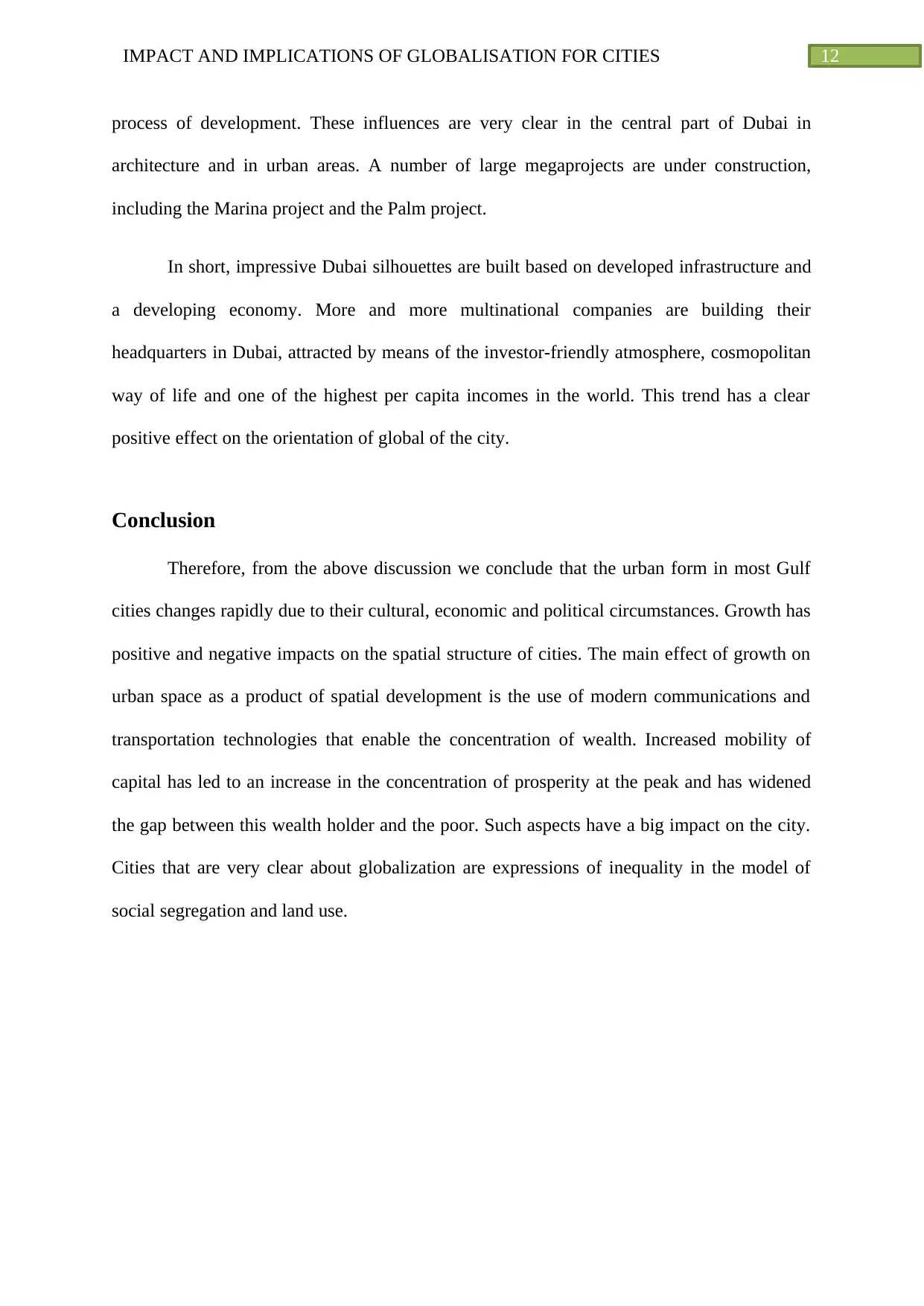
12IMPACT AND IMPLICATIONS OF GLOBALISATION FOR CITIES
process of development. These influences are very clear in the central part of Dubai in
architecture and in urban areas. A number of large megaprojects are under construction,
including the Marina project and the Palm project.
In short, impressive Dubai silhouettes are built based on developed infrastructure and
a developing economy. More and more multinational companies are building their
headquarters in Dubai, attracted by means of the investor-friendly atmosphere, cosmopolitan
way of life and one of the highest per capita incomes in the world. This trend has a clear
positive effect on the orientation of global of the city.
Conclusion
Therefore, from the above discussion we conclude that the urban form in most Gulf
cities changes rapidly due to their cultural, economic and political circumstances. Growth has
positive and negative impacts on the spatial structure of cities. The main effect of growth on
urban space as a product of spatial development is the use of modern communications and
transportation technologies that enable the concentration of wealth. Increased mobility of
capital has led to an increase in the concentration of prosperity at the peak and has widened
the gap between this wealth holder and the poor. Such aspects have a big impact on the city.
Cities that are very clear about globalization are expressions of inequality in the model of
social segregation and land use.
process of development. These influences are very clear in the central part of Dubai in
architecture and in urban areas. A number of large megaprojects are under construction,
including the Marina project and the Palm project.
In short, impressive Dubai silhouettes are built based on developed infrastructure and
a developing economy. More and more multinational companies are building their
headquarters in Dubai, attracted by means of the investor-friendly atmosphere, cosmopolitan
way of life and one of the highest per capita incomes in the world. This trend has a clear
positive effect on the orientation of global of the city.
Conclusion
Therefore, from the above discussion we conclude that the urban form in most Gulf
cities changes rapidly due to their cultural, economic and political circumstances. Growth has
positive and negative impacts on the spatial structure of cities. The main effect of growth on
urban space as a product of spatial development is the use of modern communications and
transportation technologies that enable the concentration of wealth. Increased mobility of
capital has led to an increase in the concentration of prosperity at the peak and has widened
the gap between this wealth holder and the poor. Such aspects have a big impact on the city.
Cities that are very clear about globalization are expressions of inequality in the model of
social segregation and land use.
Paraphrase This Document
Need a fresh take? Get an instant paraphrase of this document with our AI Paraphraser
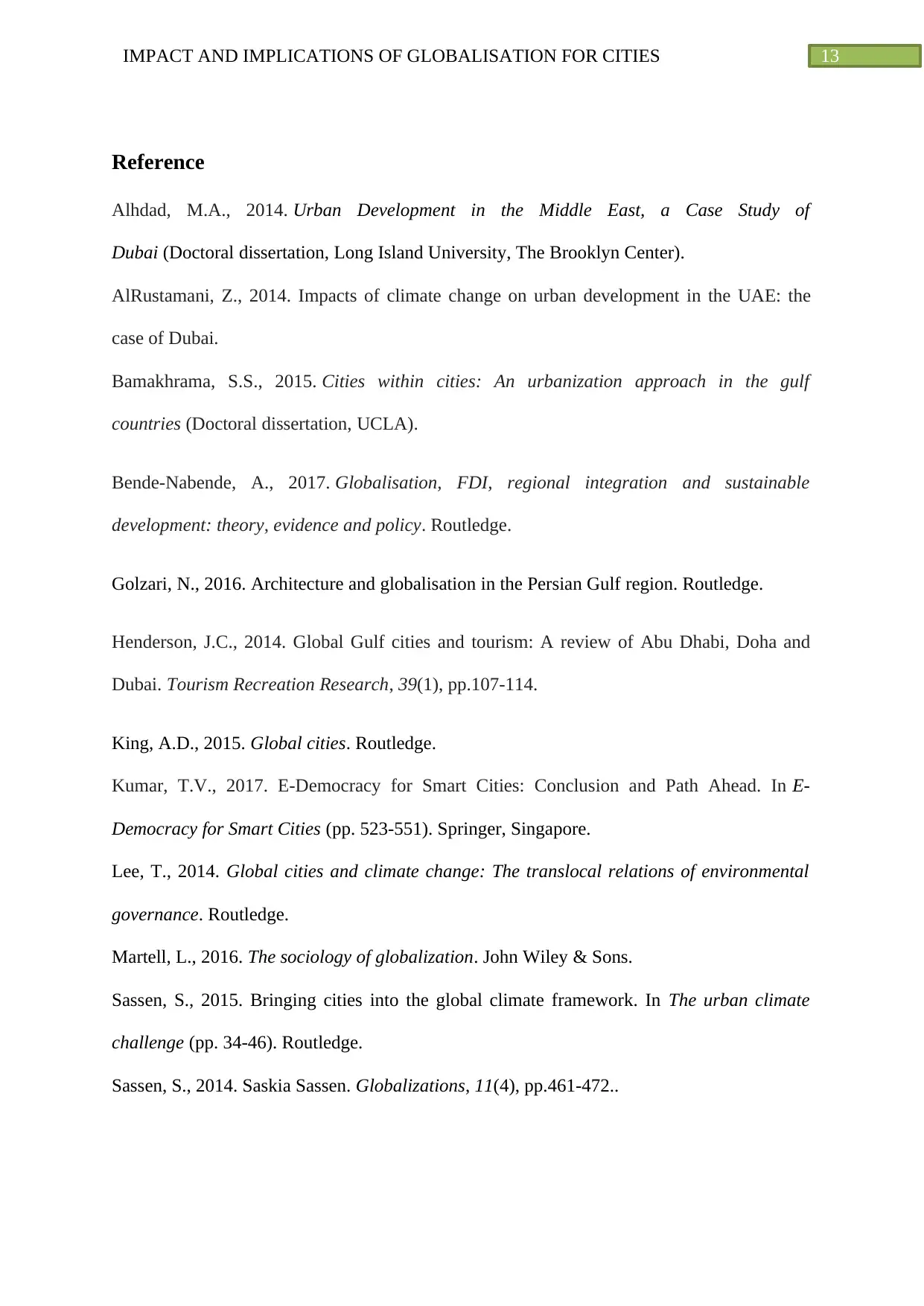
13IMPACT AND IMPLICATIONS OF GLOBALISATION FOR CITIES
Reference
Alhdad, M.A., 2014. Urban Development in the Middle East, a Case Study of
Dubai (Doctoral dissertation, Long Island University, The Brooklyn Center).
AlRustamani, Z., 2014. Impacts of climate change on urban development in the UAE: the
case of Dubai.
Bamakhrama, S.S., 2015. Cities within cities: An urbanization approach in the gulf
countries (Doctoral dissertation, UCLA).
Bende-Nabende, A., 2017. Globalisation, FDI, regional integration and sustainable
development: theory, evidence and policy. Routledge.
Golzari, N., 2016. Architecture and globalisation in the Persian Gulf region. Routledge.
Henderson, J.C., 2014. Global Gulf cities and tourism: A review of Abu Dhabi, Doha and
Dubai. Tourism Recreation Research, 39(1), pp.107-114.
King, A.D., 2015. Global cities. Routledge.
Kumar, T.V., 2017. E-Democracy for Smart Cities: Conclusion and Path Ahead. In E-
Democracy for Smart Cities (pp. 523-551). Springer, Singapore.
Lee, T., 2014. Global cities and climate change: The translocal relations of environmental
governance. Routledge.
Martell, L., 2016. The sociology of globalization. John Wiley & Sons.
Sassen, S., 2015. Bringing cities into the global climate framework. In The urban climate
challenge (pp. 34-46). Routledge.
Sassen, S., 2014. Saskia Sassen. Globalizations, 11(4), pp.461-472..
Reference
Alhdad, M.A., 2014. Urban Development in the Middle East, a Case Study of
Dubai (Doctoral dissertation, Long Island University, The Brooklyn Center).
AlRustamani, Z., 2014. Impacts of climate change on urban development in the UAE: the
case of Dubai.
Bamakhrama, S.S., 2015. Cities within cities: An urbanization approach in the gulf
countries (Doctoral dissertation, UCLA).
Bende-Nabende, A., 2017. Globalisation, FDI, regional integration and sustainable
development: theory, evidence and policy. Routledge.
Golzari, N., 2016. Architecture and globalisation in the Persian Gulf region. Routledge.
Henderson, J.C., 2014. Global Gulf cities and tourism: A review of Abu Dhabi, Doha and
Dubai. Tourism Recreation Research, 39(1), pp.107-114.
King, A.D., 2015. Global cities. Routledge.
Kumar, T.V., 2017. E-Democracy for Smart Cities: Conclusion and Path Ahead. In E-
Democracy for Smart Cities (pp. 523-551). Springer, Singapore.
Lee, T., 2014. Global cities and climate change: The translocal relations of environmental
governance. Routledge.
Martell, L., 2016. The sociology of globalization. John Wiley & Sons.
Sassen, S., 2015. Bringing cities into the global climate framework. In The urban climate
challenge (pp. 34-46). Routledge.
Sassen, S., 2014. Saskia Sassen. Globalizations, 11(4), pp.461-472..
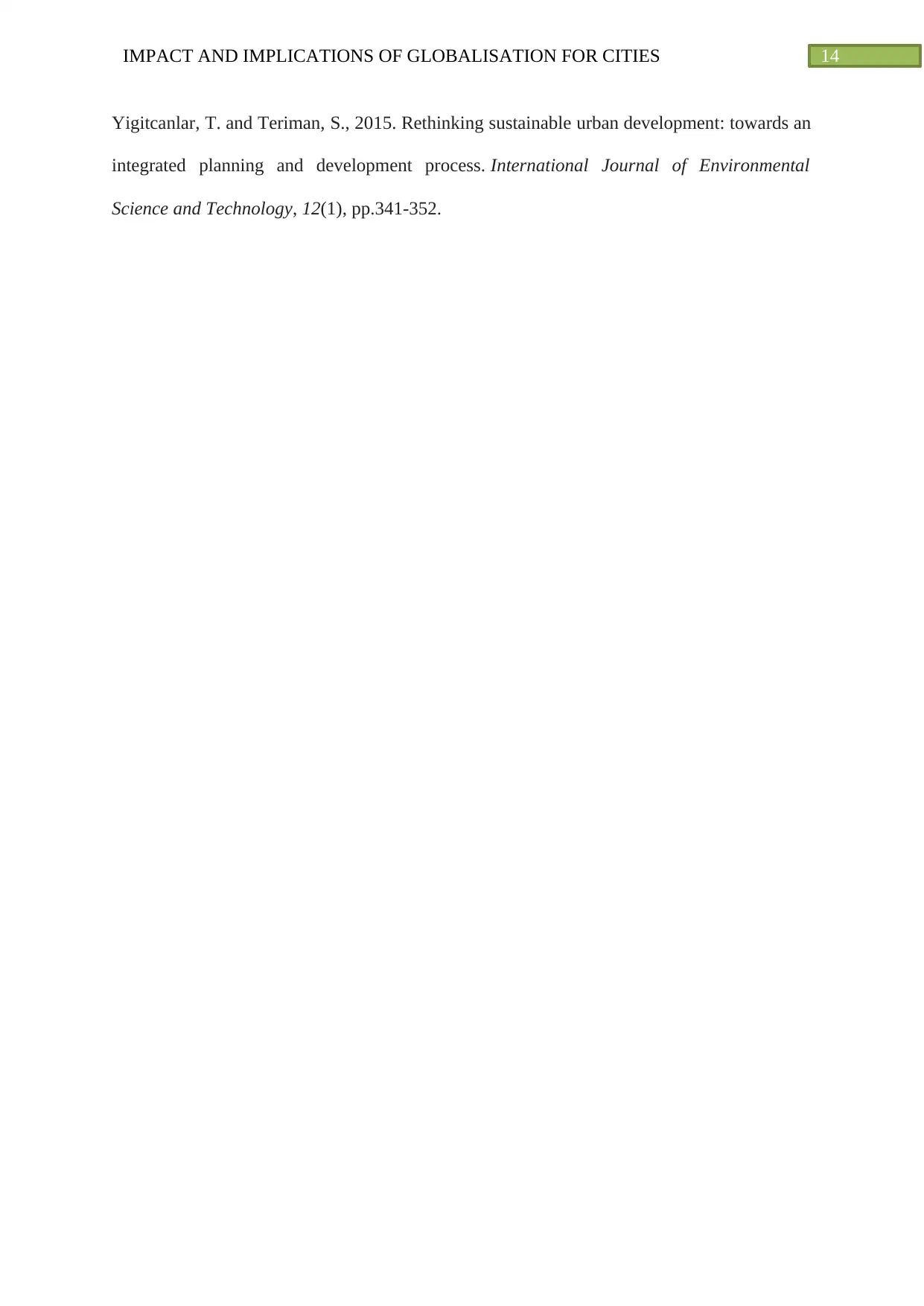
14IMPACT AND IMPLICATIONS OF GLOBALISATION FOR CITIES
Yigitcanlar, T. and Teriman, S., 2015. Rethinking sustainable urban development: towards an
integrated planning and development process. International Journal of Environmental
Science and Technology, 12(1), pp.341-352.
Yigitcanlar, T. and Teriman, S., 2015. Rethinking sustainable urban development: towards an
integrated planning and development process. International Journal of Environmental
Science and Technology, 12(1), pp.341-352.
1 out of 15
Related Documents
Your All-in-One AI-Powered Toolkit for Academic Success.
+13062052269
info@desklib.com
Available 24*7 on WhatsApp / Email
![[object Object]](/_next/static/media/star-bottom.7253800d.svg)
Unlock your academic potential
© 2024 | Zucol Services PVT LTD | All rights reserved.





